FEDS Notes
March 24, 2023
Gender Gaps in the Labor Market Widen Every Summer
Brendan M. Price and Melanie Wasserman1
Introduction
Gender gaps in labor market activity are pervasive, longstanding, and a regular subject of policy debates. Relative to men, women tend to work fewer hours per week, more conventional hours, and fewer years over the course of their lives.2 These differences in the intensity and timing of work contribute to gender disparities in promotions and pay.3 But despite decades of research on this topic, little attention has been paid to the timing of work throughout the year. To motivate our inquiry, Figure 1 plots the monthly labor force participation rates of prime-age US women and men using non–seasonally adjusted data, with June, July, and August shaded gray. Summer after summer, women's labor force participation drops sharply while men's participation does not.
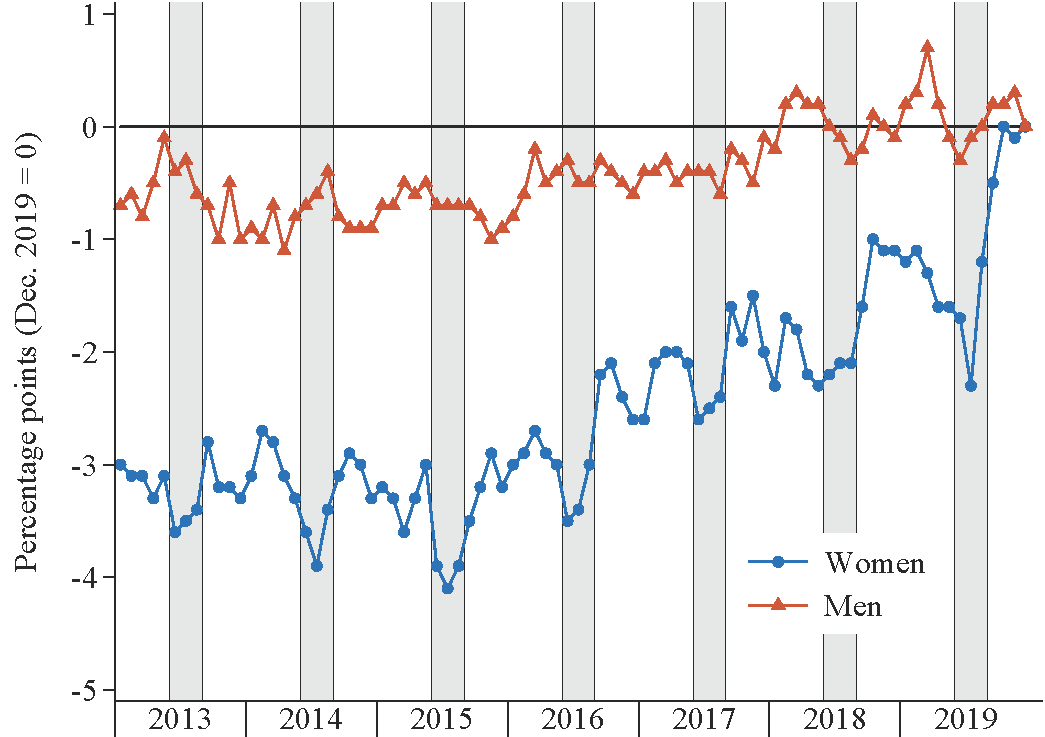
Note: Non–seasonally adjusted labor force participation rates among individuals aged 25–54, normalized to zero in December 2019. Shaded regions correspond to the months of June, July, and August.
Source: Bureau of Labor Statistics, Labor Force Statistics.
In this Note, we summarize some of the key findings from our research paper "The Summer Drop in Female Employment", available at SSRN (https://dx.doi.org/10.2139/ssrn.4352186). First, we document that women's employment and hours worked fall consistently during the summer months. Next, we show that school closures for summer break—and consequent lapses in school-provided childcare—are the root cause of these declines. We then explain how women's lower employment rate over the summer reflects both sectoral sorting and gender disparities among workers in similar job types. Lastly, we discuss ramifications for the gender gap in pay.
I. Summer declines in women's employment and hours
We estimate seasonal shifts in labor market activity among US adults aged 25–49 using Current Population Survey (CPS) data spanning the years 1989–2019.4 The CPS reports individuals' labor market activity during each month's reference week, which usually coincides with the 12th day of the month.
Figure 2 plots the typical evolution of women's and men's labor force status throughout the year, with all changes expressed relative to the month of May. Between May and July, women's employment-to-population ratio (EPOP) declines by 1.1 percentage points (top panel), whereas men's EPOP edges up slightly (bottom panel).5
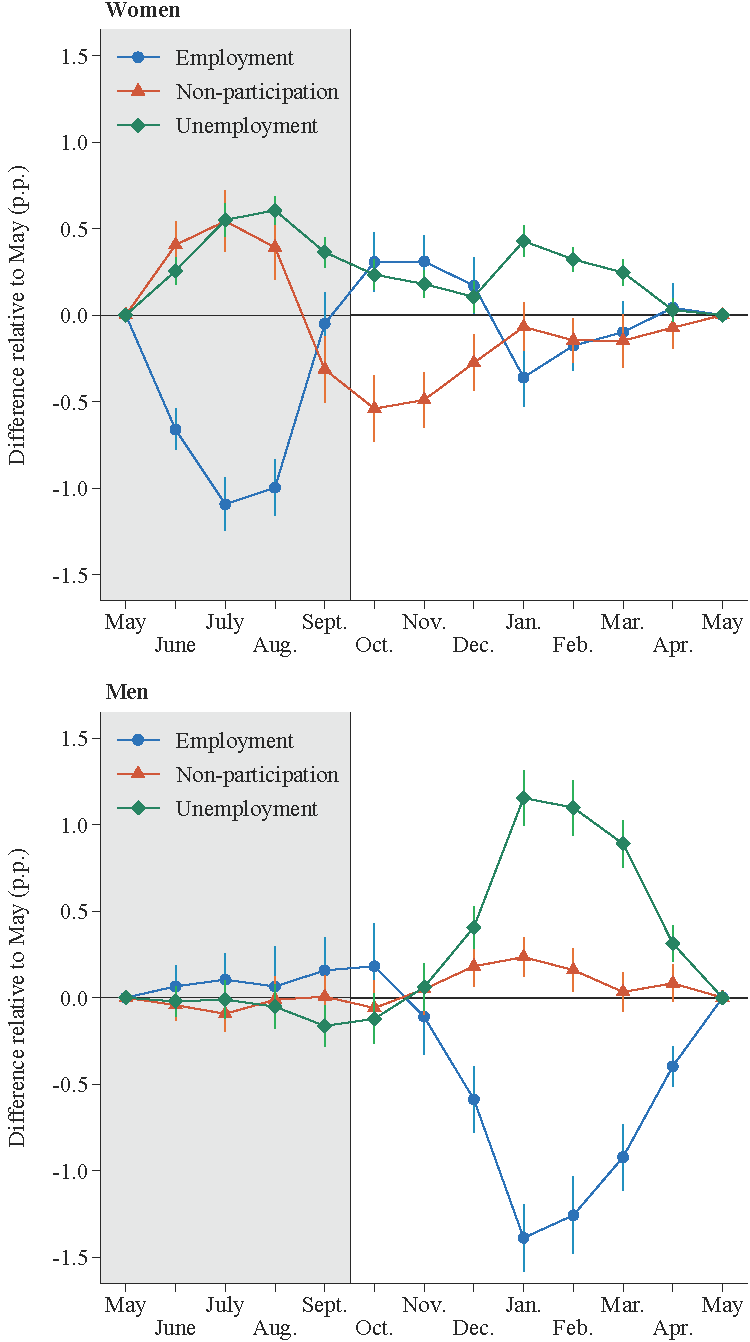
Note: Estimated seasonal changes in employment, unemployment, and non-participation as shares of the population aged 25–49, relative to the month of May. Vertical bars show 95 percent confidence intervals.
Source: Current Population Survey via IPUMS (Flood et al., 2021) and authors’ calculations.
The summer drop in female employment is driven in equal parts by an increase in unemployment and an increase in labor force non-participation. These seasonal changes are economically meaningful: the May-to-July drop in female EPOP amounts to nearly one-third of its peak-to-trough decline during the Great Recession.
The drop in employment is reinforced by a much steeper decline in women's hours worked, which plunge by 11.2 percent between May and July. Some of this decline stems directly from reduced employment, but most of it reflects absences from work among those who remain continuously employed. Men's hours also decline, but only by 5.2 percent. Although both men and women take time off over the summer, the much bigger drop among women points to summer work patterns as a potential contributor to gender gaps in earnings, as we explore in Section IV below.
II. School closures and childcare disruptions
Why do women work less over the summer? It turns out that a fixture of the US educational system—summer break—is at the root of the decline.
When schools close for the summer, childcare needs change dramatically. Survey data reveal how parents use a patchwork of childcare arrangements to account for the six hours per weekday that their children previously spent in school.6 Over 40 percent of working parents pay for summer childcare, including camps and summer school. Other parents lean on relatives for care or have their children look after themselves. Over half of parents report that at least one parent in the household plans to make a job sacrifice to accommodate summer childcare needs. Since women shoulder the lion's share of childcare responsibilities, it is likely that school closures disproportionately affect their employment.7
Because schools tend to let out at different times in different states, we can see whether women's drop in employment coincides with the beginning of summer break in their state. For example, most schools in the Midwest, Southwest, and South Atlantic states close by mid-June, while most schools in the Northeast and in Washington State close between mid-June and mid-July.8 As shown in Figure 3, the summer drop in female employment is tightly synchronized with the onset of summer break. In early-closure states, women's employment falls sharply between the May and June reference weeks; in late-closure states, their employment instead holds steady through June and falls only in July.
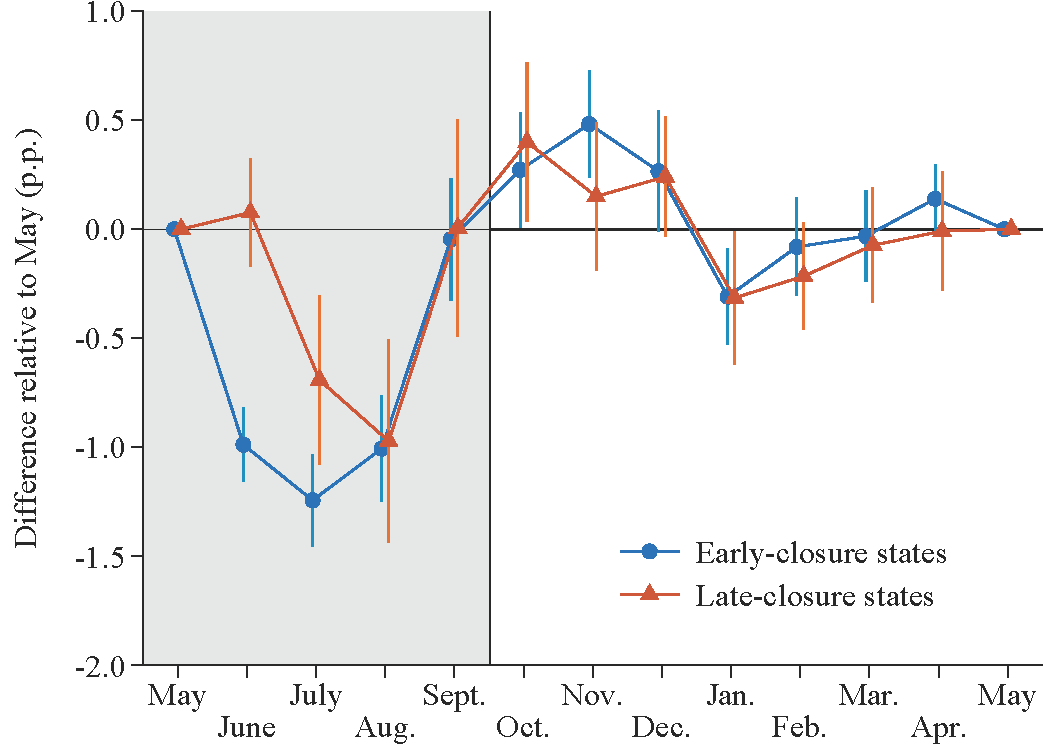
Note: Estimated seasonal changes in the female employment-to-population rate in states where K–12 school closures are mostly in effect by mid-June or mostly in effect only as of mid-July. Vertical bars show 95 percent confidence intervals.
Source: Current Population Survey via IPUMS (Flood et al., 2021) and authors’ calculations.
The summer lapse in school-provided childcare matters most for women whose children are old enough to attend school but young enough to require supervision during summer break. As shown in Figure 4, employment among mothers whose youngest child is aged 6–12 declines by fully 2.3 percentage points between May and July. The decline is smaller, though still sizable, among other mothers and among women without children.
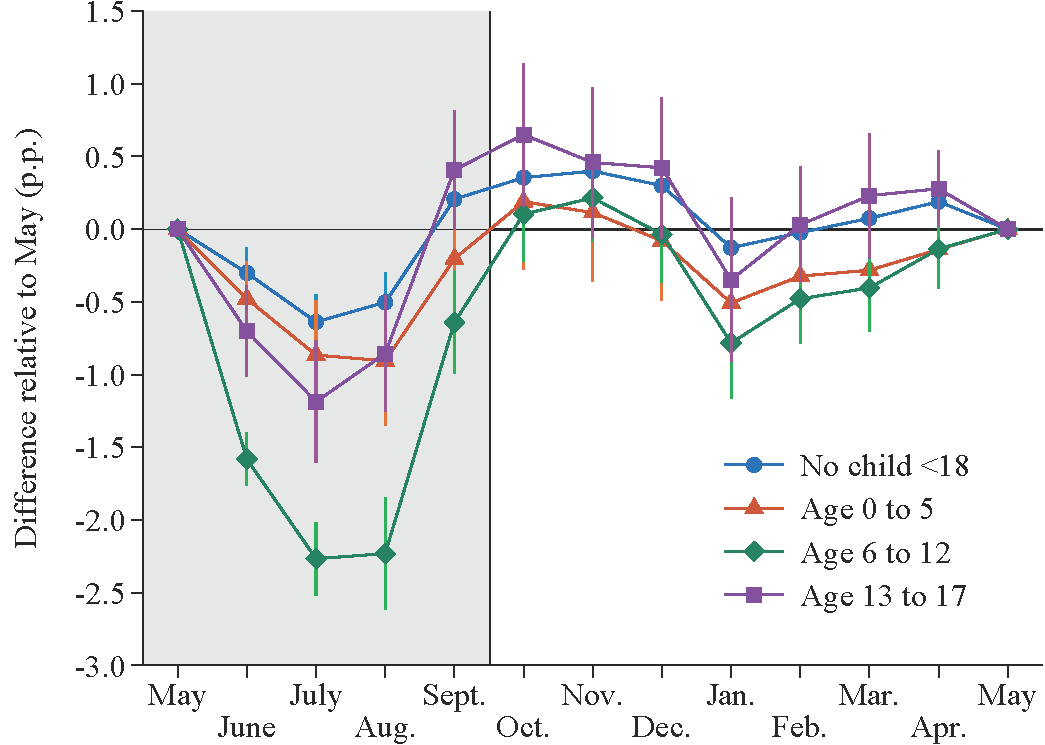
Note: Estimated seasonal changes in the female employment-to-population rate. Parental status is based on own biological, adopted, or step-children residing in the same household. Vertical bars show 95 percent confidence intervals.
Source: Current Population Survey via IPUMS (Flood et al., 2021) and authors’ calculations.
Consistent with school closures disrupting an important mode of childcare, mothers of young school-age children report a sharp uptick in time spent on childcare over the summer months. Using data from the American Time Use Survey, we tally up all childcare time—whether it is the mother's primary activity or done alongside another task such as household chores. Childcare time is elevated throughout the summer, rising by nearly 9 hours per week from May to July.9
III. The role of education-sector jobs
One might think that the summer drop in employment simply reflects the fact that women are more likely to work in the education sector, where work schedules track the school calendar. But only about a third of the gender gap in summer employment is due to this kind of sorting.10
More subtle forms of sorting play a role, as well. Within the education sector, women tend to sort into occupations that contract more during the summer months. Outside of education, men are more likely to work in sectors like construction that boom in warmer weather, which sustains their employment rates through the summer months.
All told, however, gender differences in sorting across sectors and occupations can account for only half of the disparity in summer work. The remainder stems from seasonal differences in employment between women and men working in similar jobs. Within narrowly defined occupations in the education sector—such as secondary school teachers or bus drivers—women are more likely than men to exit employment over the summer. Further detail comes from the Schools and Staffing Survey, which shows that female teachers are less likely to engage in school-based summer work, such as teaching classes or coaching sports, and are also less likely to bridge the summer break with work outside the school setting.11 In other sectors, too, women exit employment over the summer at higher rates than their male counterparts. Throughout the labor market, women's employment falls relative to men's when schools are on summer break.
IV. Ramifications for gender gaps in pay
Does the summer drop in female employment contribute to gender gaps in pay? It could do so through several channels. First, women's reduced hours over the summer translate directly into reduced summer earnings. As shown in Figure 5, women's weekly earnings fall by an average of 3.3 percent over the summer months, about five times the decline among men.12
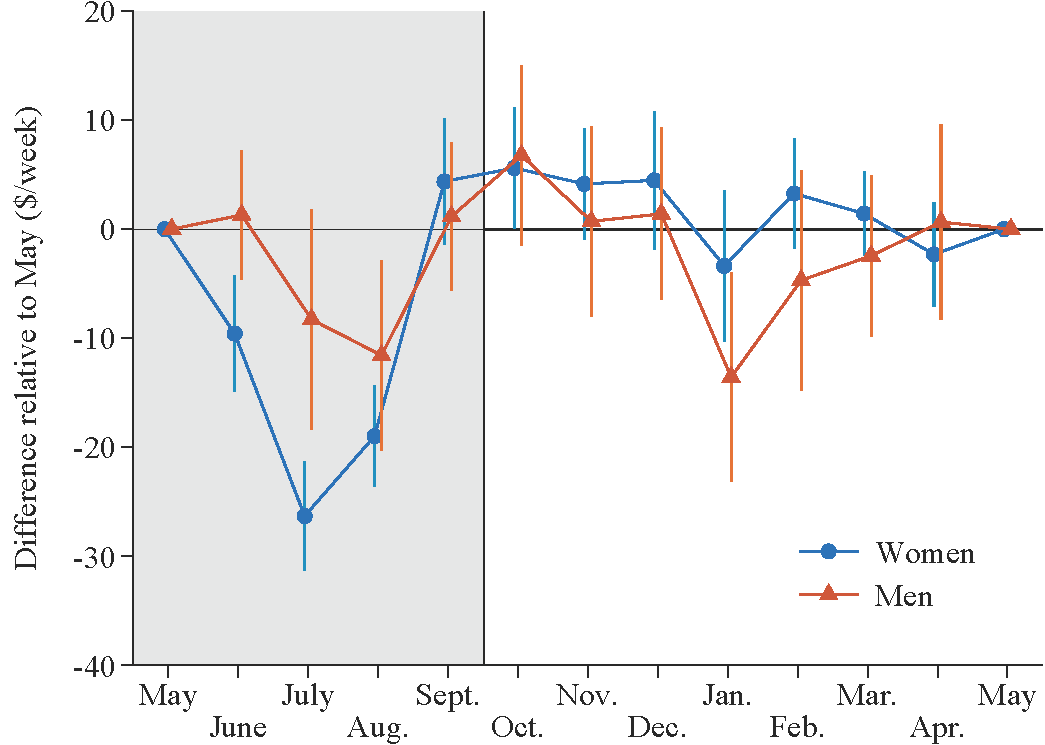
Note: Estimated seasonal changes in weekly earnings. Vertical bars show 95 percent confidence intervals.
Source: Current Population Survey via IPUMS (Flood et al., 2021) and authors’ calculations.
Second, summer work interruptions may impede women's accumulation of human capital or worsen their odds of promotion. While we do not have direct empirical evidence on this point, prior research on the gender gap has emphasized the importance of continuous employment for earnings growth over the life cycle.13 Time spent out of the labor force or working at reduced intensity—notably after childbirth—carries a significant earnings penalty.
Third, women navigating childcare needs may accept lower pay to access jobs that offer flexible summer hours. Education jobs, in particular, offer a unique form of summer flexibility, since their work demands align naturally with the school year.14 When we examine jobs that are common both in and outside of education, such as administrative assistants or bus drivers, we find that women systematically sort into the education-sector version of the job. Since education jobs pay less than their non-education counterparts, these patterns suggest that women may be trading off compensation for access to summer flexibility.
The summer drops in women's employment, hours, and earnings underscore how schools' closures for summer break may exacerbate gender disparities in the labor market. Policy options such as extending the school year, broadening access to summer school, or increasing government support for summer childcare could potentially address these disparities.
References
Bertrand, Marianne, Claudia Goldin, and Lawrence F. Katz. 2010. "Dynamics of the Gender Gap for Young Professionals in the Financial and Corporate Sectors." American Economic Journal: Applied Economics, 2(3): 228–255.
Blau, Francine D. and Lawrence M. Kahn. 2017. "The Gender Wage Gap: Extent, Trends, and Explanations." Journal of Economic Literature, 55(3): 789–865.
Bolotnyy, Valentin and Natalia Emanuel. 2022. "Why Do Women Earn Less than Men? Evidence from Bus and Train Operators." Journal of Labor Economics, 40(2): 283–323.
Capizzano, Jeffrey, Sarah Adelman, and Matthew Stagner. 2022. "What Happens When the School Year Is Over? The Use and Costs of Child Care for School-Age Children During the Summer Months". Urban Institute Occasional Paper No. 58.
Coglianese, John and Brendan M. Price. 2020. "Income in the Off-Season: Household Adaptation to Yearly Work Interruptions". Finance and Economics Discussion Series 2020-084, Federal Reserve Board of Governors.
Cortés, Patricia and Jessica Pan. 2019. "When Time Binds: Substitutes for Household Production, Returns to Working Long Hours, and the Skilled Gender Wage Gap." Journal of Labor Economics, 37(2): 351–398.
Cubas, German, Chinhui Juhn, and Pedro Silos. 2022. "Coordinated Work Schedules and the Gender Wage Gap." Economic Journal. Accepted manuscript.
Flood, Sarah, Miriam King, Renae Rodgers, Steven Ruggles, J. Robert Warren, and Michael Westberry. 2021. "Integrated Public Use Microdata Series, Current Population Survey: Version 9.0 [dataset]." Minneapolis, MN: IPUMS. https://doi.org/10.18128/D030.V9.0.
Goldin, Claudia. 2014. "A Grand Gender Convergence: Its Last Chapter." American Economic Review, 104(4): 1091–1119.
Novoa, Christina. 2019. "When Parents Can't Find Summer Child Care, Their Work Suffers." Center for American Progress Report.
Wasserman, Melanie. 2022. "Hours Constraints, Occupational Choice, and Gender: Evidence from Medical Residents." Review of Economic Studies, forthcoming.
Wiswall, Matthew and Basit Zafar. 2018. "Preference for the Workplace, Investment in Human
Capital, and Gender." Quarterly Journal of Economics, 133(1): 457–507.
1. Brendan Price is employed at the Federal Reserve Board. Melanie Wasserman is employed at UCLA. The views expressed here are strictly those of the authors and do not necessarily represent the views of the Federal Reserve Board or its staff. Return to text
2. See Bertrand, Goldin, and Katz (2010); Bolotnyy and Emmanuel (2022); Cortés and Pan (2019); Cubas, Juhn, and Silos (2022); Wasserman (2022); and Wiswall and Zafar (2018). Return to text
3. See Goldin (2014) and Blau and Kahn (2017). Return to text
4. We access CPS data via IPUMS (Flood et al., 2021). To isolate seasonal patterns, we regress each outcome variable on a set of indicator variables for each calendar month, controlling for a linear spline in calendar time to absorb long-term trends and fluctuations over the business cycle. We also control for the number of weeks elapsed between successive CPS reference weeks. We estimate all specifications on data grouped to the year–month level, and we construct 95 percent confidence intervals using Newey-West standard errors that allow for serial correlation in the error term. Return to text
5. Employment also falls sharply each winter, especially for men, reflecting layoffs in construction and other weather-sensitive sectors as well as a contraction in retail employment after the holiday season. Related work by Coglianese and Price (2020) analyzes the extent to which those experiencing seasonal work interruptions recoup lost earnings during the off-season. Return to text
6. See Novoa (2019) and Capizzano et al. (2022). Return to text
7. While we focus our discussion on disruptions to childcare, school closures could also disproportionately affect women's employment if women prefer to spend time with their children when they are off from school. Return to text
8. School calendars vary both between states and across school districts within a state. We determine the typical timing of school closures in each state using CPS data on whether 16-year-old respondents are present at school during the monthly reference week. We classify a state as having early closures if at least two-thirds of the total May–July drop in school attendance occurs between May and June and as having late closures if at least two-thirds of this decline occurs between June and July. This classification leaves out a set of states with closures spread more evenly across these months. Return to text
9. Fathers of young school-age children experience a smaller and more fleeting increase in time spent on childcare during the summer. This increase likely reflects family vacations, as it is driven by childcare as a secondary activity alongside leisure activities. Return to text
10. Throughout this section, we quantify the roles of sectoral sorting, occupational sorting, and gender differences within job types using a statistical method known as Oaxaca-Blinder decomposition. Return to text
11. We use data from the 1993 Schools and Staffing Survey, published by the National Center for Education Statistics. Summer gaps between male and female teachers persist in a multivariate regression that controls for school type, subject, teaching experience, and demographic characteristics. Return to text
12. The CPS does not directly report workers' weekly earnings. For workers paid on an hourly basis, we set earnings equal to their hourly wage multiplied by their hours worked during the reference week. For salaried workers, we set earnings equal to their usual weekly earnings but zero them out for workers on unpaid leave. Figure 5 depicts earnings changes in dollar terms; the gender disparity in the summer drop is larger in percent terms than in dollar terms owing to women's lower average earnings. Return to text
13. See Bertrand, Goldin, and Katz (2010). Return to text
14. While women might prefer to work in the education sector for a host of reasons, we find that women gravitate towards the education sector especially when their children are old enough to start attending school. Return to text
Price, Brendan M., and Melanie Wasserman (2023). "Gender Gaps in the Labor Market Widen Every Summer," FEDS Notes. Washington: Board of Governors of the Federal Reserve System, March 24,2023, https://doi.org/10.17016/2380-7172.3274.
Disclaimer: FEDS Notes are articles in which Board staff offer their own views and present analysis on a range of topics in economics and finance. These articles are shorter and less technically oriented than FEDS Working Papers and IFDP papers.